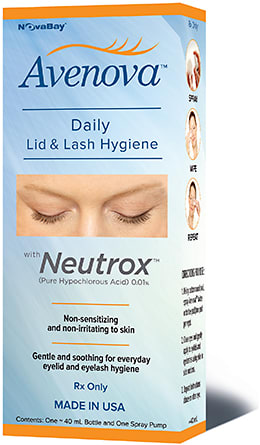Therapy Focus
Lid hygiene provides patient relief
How a lid scrub system helped a challenging case of ocular surface and lid margin disease.
BY STEVEN I. ROSENFELD, MD, FACS
A recent 68-year-old patient with recalcitrant ocular surface and lid margin disease reinforced the importance of managing a patient’s lid hygiene.
Despite seeing about eight other ophthalmologists prior to his visit, the patient said he failed to gain relief. A treatment regimen that included a prescription lid hygiene product (NovaBay’s Avenova with Neutrox — previously known as i-Lid Cleanser) ultimately proved effective.
Product overview
Avenova is indicated to cleanse and remove foreign material, including microorganisms and skin debris.1 Avenova can also serve as part of the lid and lash hygiene regimen starting one week prior to intraocular surgery. Also, Avenova is non-toxic, non-sensitizing, and non-irritating to the skin and eyes.1 Thus, no special handling of the product is required.
The product is indicated for twice-daily and as-needed use due to its non-irritating formulation. Avenova contains Neutrox, 0.01% pure hypochlorous acid (HOCl) in a normal saline solution. HOCl is an endogenous compound produced in the human body as an element of the immune response.2 During a process termed the “oxidative burst,” small highly reactive molecules generate as white blood cells encounter invading pathogens in the body.3 In the innate immune system, neutrophils are the major producers of HOCl.

Finding a solution
The patient who referred to my office had a two-year history of dry eye disease (DED) and blepharitis that he believed started immediately after bilateral cataract surgery. He described constant and chronic symptoms of dry eyes, redness, tearing, intermittent foreign body sensation, and sharp shooting pains, worse in his left eye than the right, although these pains did not awake him. Also, he noted aberrant eyelashes that he self-epilated with a tweezer and a 15X magnifying mirror at home. He specifically stated that all previous attempts with eye scrubs actually made his eyes feel worse and his vision blurry.
He received multiple diagnoses of DED, blepharitis, corneal edema, and trichiasis and had been treated with an armamentarium of drops, ointments, tears, warm compresses, baby shampoo lid scrubs, lid scrubs, and occlusive sunglasses. Unfortunately, no medications or treatment regimens worked.
His past medical history included diet-controlled diabetes mellitus, Crohn’s disease (in remission), sleep apnea, thyroidectomy for thyroid cancer, prostatectomy with radiation therapy for prostate cancer, and a spinal fusion operation. An allergist told him he had an allergy to dust mites. His current list of systemic medications included bupropion (Wellbutrin, Valeant), eszopiclone (Lunesta, Sunovion), gabapentin (Neurontin, Pfizer), testosterone, thyroxine, baclofen, armodafinil (Nuvigil, Cephalon), and fish oil.
When I first examined this patient he used cyclosporine 0.05% drops in both eyes twice a day, prednisolone acetate 1% drops orally once a day, and tea tree oil in both eyes twice a day. His exam was significant for facial stigmata of rosacea, bilateral upper and lower lid trichiasis, bilateral upper lid lash ptosis, moderate seborrheic blepharitis and meibomian gland inspissation, clear corneas without punctate keratitis or edema, deep and quiet anterior chambers, well-placed posterior-chamber intraocular lenses in both eyes, and a normal fundus exam without diabetic retinopathy.
Our primary goal
In addition to seeing the patient on a regular basis for epilation of his recurrent trichiatic eyelashes and having him continue his medications as outlined above, I added doxycycline 50 mg once a day and Avenova with Neutrox once a day.
As a non-antibiotic topical antimicrobial agent, Avenova addresses concerns with growing bacterial resistance to existing antibiotics.4 Also, it is formulated without soaps, detergents, or surfactants. In vitro studies have shown that Avenova with Neutrox provides rapid eradication (≥99.99% killing within 60 seconds) of 20 species of pathogens including aerobic and anaerobic Gram-positive bacteria, such as Staphylococcus aureus (MRSA).1 This rapid killing of microorganisms helps prevent harmful biofilms from forming.5 In addition, Neutrox in vitro inactivates bacterial toxins that can cause inflammation.
After two weeks, the patient felt much better and progressed with each subsequent visit. When last examined two months after starting Avenova treatment, he was very pleased with the comfort of the lid scrub system, and the treatment effectively controlled the patient’s lid margin disease. Interestingly, his slit lamp exam still demonstrated mild residual seborrheic blepharitis and meibomian gland frothing, but no conjunctival injection or corneal staining. Avenova has helped me to make this patient comfortable, which is our primary goal when treating many diseases and particularly with this challenging patient.
Conclusion
Due to Neutrox’s unique characteristics and beneficial tolerability profile, I would recommend Avenova for any lid hygiene regimen, including dry eye, blepharitis, ocular surgery and contact lens wear. OP
REFERENCES:
1. Avenova with Neutrox [Package Insert]. Emeryville, CA. NovaBay Pharmaceuticals, Inc.; 2014.
2. Hurst JK. What really happens in the neutrophil phagosome? Free Radic Biol Med 2012;53:508-520.
3. Gray MJ, Wholey WY, Jakob U. Bacterial responses to reactive chlorine species. Annu Rev Microbiol. 2013;67:141-160.
4. Debabov D. Antibiotic resistance: origins, mechanisms, approaches to counter. Appl Biochem Microbiol. 2013;49:1-7.
5. Crew J, Varilla R, Rocas TA, et al. NeutroPhase in chronic non-healing wounds. Int J Burns Trauma. 2012;2:126-134.

|
Dr. Rosenfeld is a fellowship trained Cornea and External Disease specialist practicing with the Delray Eye Associates, PA, and is a voluntary professor at the Bascom Palmer Eye Institute in Miami, FL, and the University of Miami School of Medicine. |








